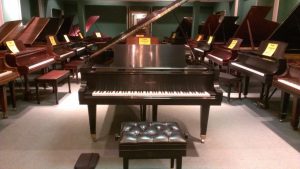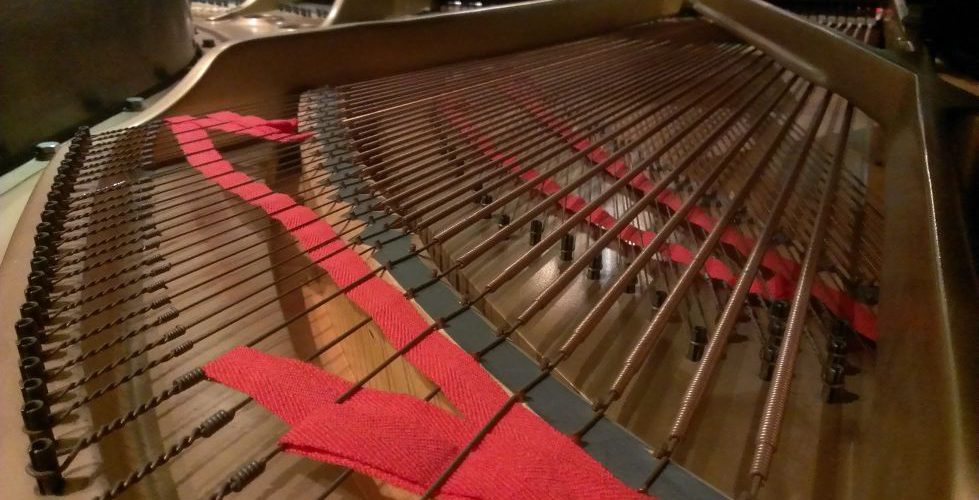How To Choose a Piano
Once we knew we were ready, the onus fell on me (being the primary pianist in the house) to figure out how to choose a piano. I went to a handful of piano stores in the Washington, DC area and played all sorts of pianos, but at first I didn’t really know how to recognize the “right one” for our musical preferences. I play professionally, usually within the genres of jazz and inspirational. There aren’t any kids in the house (for the time being!), but I give lessons at home.
After some online research, talking to a few experienced piano dealers, and lots of playing, I started feeling better about how to choose a piano. Here is my understanding thus far.
The Layout & Where To Start
Typically when you enter a piano warehouse you first see dozens of shiny, medium-sized grand pianos. In general, they are made by companies like Yamaha, Kawai, Young Chang, Boston, Kimball, and Samick and sizes range from 4’ 5” (baby grands) to around 6’ (parlor grands).
These tend to have a bright and clear sound that, to me, is very plain and simple. They don’t necessarily have much individual personality or character in tone, and while fun to bang on, it’s harder to coax rich and complex dynamics out of them.
That being said, these small-to-medium-sized grands are good if you have the budget for something pretty, if you have enough space, and for intermediate to advanced players. Beginners are alright too, but kids in particular tend to explore and bang around a lot on the keys. This is good for learning and not necessarily bad for the piano, but the extra money you’re paying won’t be appreciated. Also, you don’t want to worry too much about keeping up its appearance.
Off to the side of the sales floor there will probably be dozens of glossy black upright pianos from a variety of makers. The heights range from my elbow to my chin. Some are new, some used. Being in the market for a grand, however, I didn’t spend much time on these.
However, this is the kind of piano you want for children who are have been playing for three years or less. It will be easier to maintain and less risky of an investment. Let them play for a while and see if they like piano enough to play for several more years. My parents had an upright on which I spent my first 4-5 years playing, then they brought home a 5’ 7” Young Chang grand. At this point in my music life, the grand opened up all sort of sounds and options that I’d never imagined … but I wouldn’t have appreciated it until then anyway.

Somewhere in the back, after the shiny grands and uprights, you’ll typically find a smaller room with and handful of large grand pianos. These are the highest quality. They tend to be at least 5’ 7” in length and go all the way up to 9’ concert grands. Steinway is probably the most common make, but you’ll also see Bösendorfer, Mason & Hamlin, Baldwin, Schimmel, and others.
The instruments in this back room vary substantially. Legs, benches and music stands come in a variety of shapes and ornamentations. Some pianos sound bright, many are mellow. There is un-shiny black, rosewood, and several shades of brown. When played, most have an amazing amount of soft and rich dynamics. Some have beautiful round tones straight out of the 19th century (literally, in the case of one 1896 piano that I spent some time with), others have a depth that is snazzy and modern, and yet others have simply a large, complete sound.
If you’re looking for a fine instrument in which to invest, and if you’re sure the piano will be used for years by intermediate or advanced players and not turn into an expensive piece of furniture, definitely have a look in this room. The pianos are rich in character, and many convey individual personalities which you’ll be able to identify with.
But what is “character”? How can you hear it? I had to ask many questions and play a lot of pianos to understand. Read more on how to choose a piano:
- Piano Character » (what does this mean, anyway?)
- Best Piano Brands » (IMO)
- How To Pick a Piano » (at the keys)

2 Replies to “How To Choose a Piano”
Comments are closed.